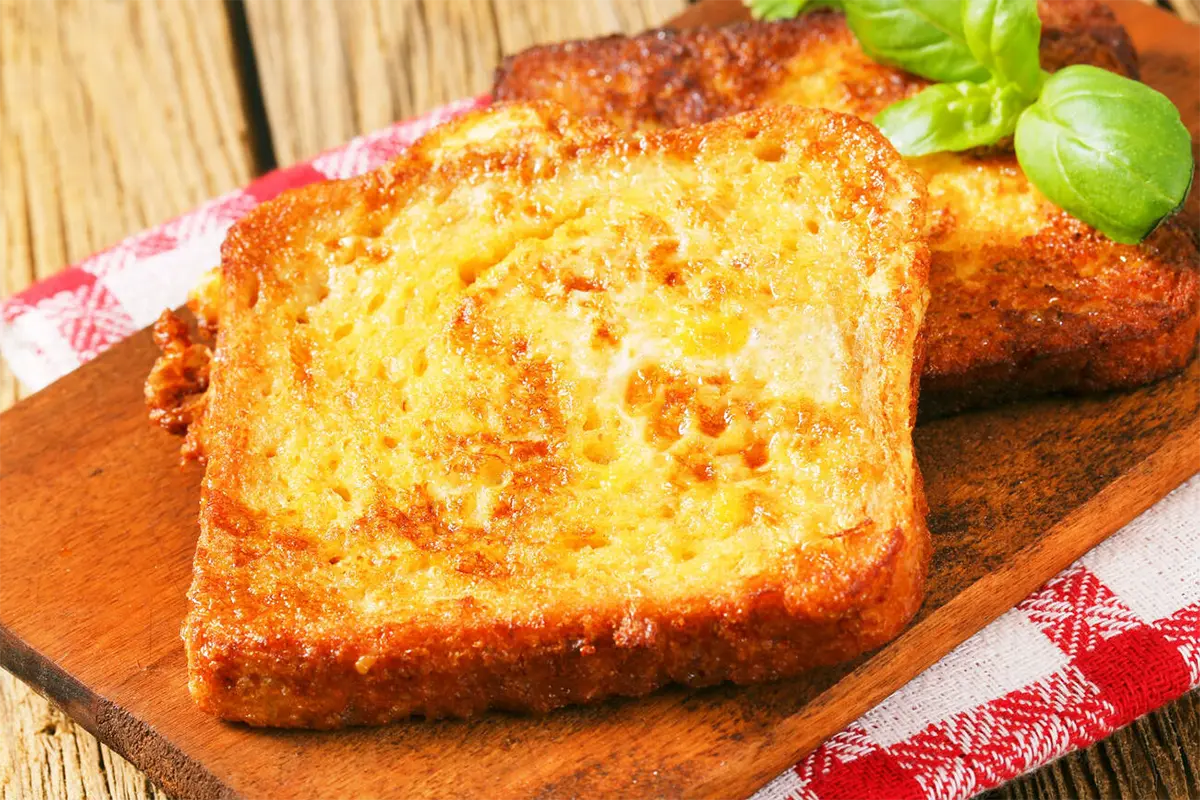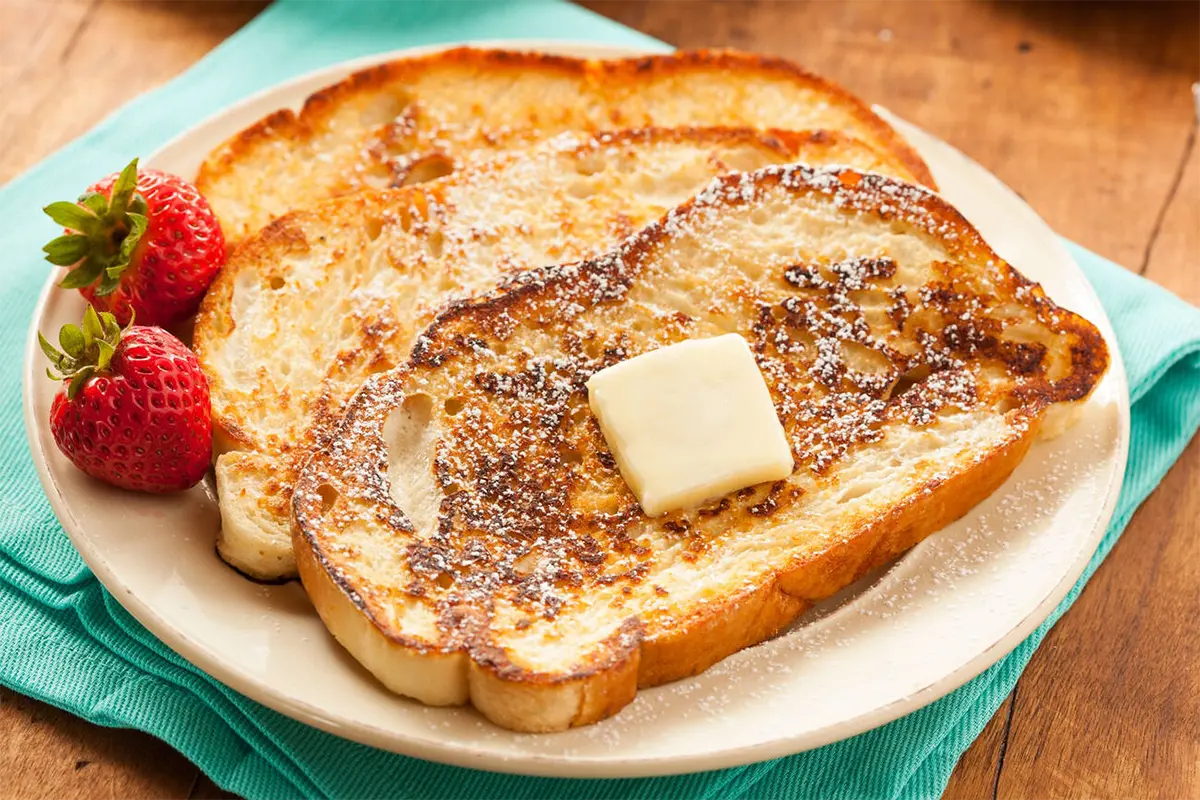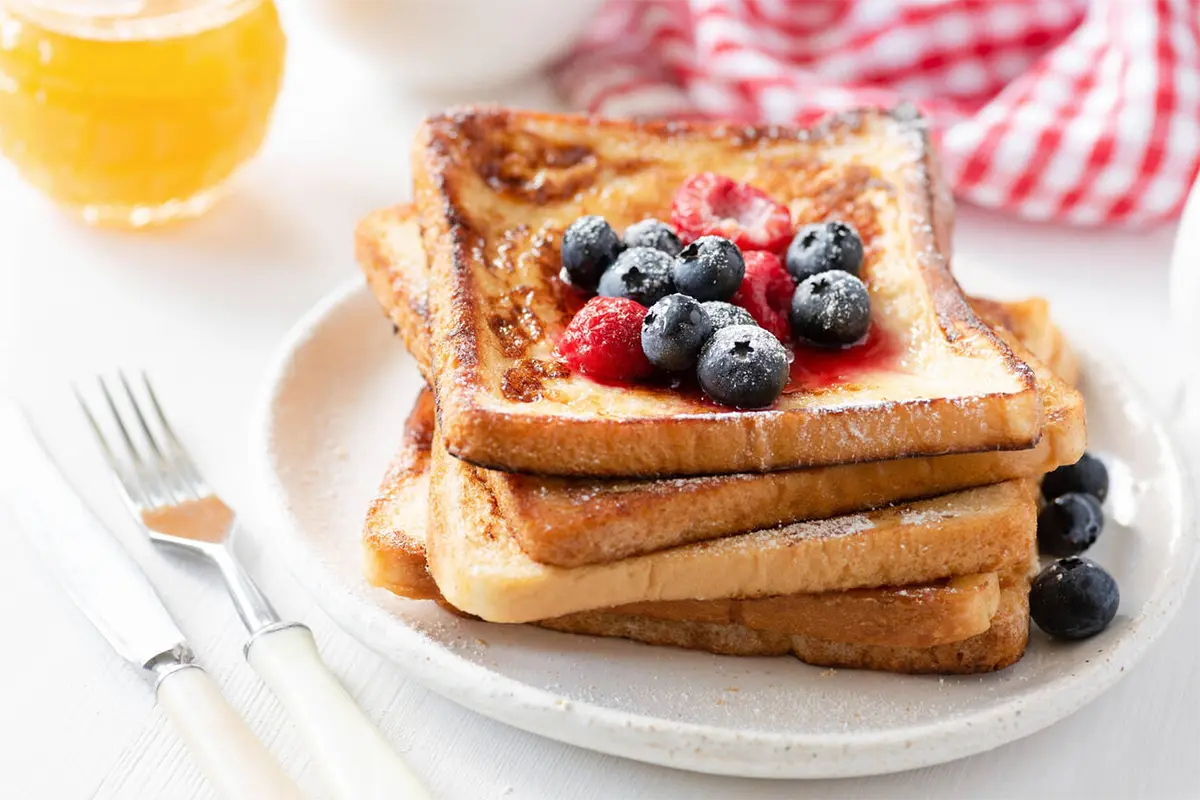Introduction to French Toast
Ah, French toast! It’s the breakfast of champions, a canvas for culinary creativity, and, quite frankly, an incredibly delicious way to start your day. But what’s the secret behind this beloved dish? Lean in close, because we’re about to dive deep into the enchanting world of French toast.
The Delightful World of French Toast
French toast is much more than a meal; it tells a story on a plate. Originating from the heart of France, this dish ingeniously transformed stale bread into a breakfast that excites. Today, French toast graces breakfast menus worldwide, winning hearts of all ages.
A Brief History and Why It’s a Breakfast Favorite
The charm of French toast lies in its simplicity and adaptability. Bread, eggs, and milk, sprinkled with a bit of culinary magic, breathe new life into stale bread. This dish demonstrates that exceptional food doesn’t need to be complicated. And its versatility! Whether you lean towards sweet or savory, French toast satisfies every craving. Adorn it with maple syrup, powdered sugar, or fresh berries; the choices are limitless.
You might wonder, “Isn’t it just dipped and fried bread?” But there’s more to it. French Toast Perfection relies on the right ingredients and techniques. The choice of bread and achieving that golden-brown crust are crucial. Indeed, the type of bread can elevate French toast from good to exceptional.
So, if you’re a French toast aficionado or a curious newcomer ready to up your breakfast game, stay with us. We’re going to uncover the secrets that turn French toast from an ordinary meal into a celebration of flavors and textures. Get ready to master the flip and discover breakfast bliss!
The Building Blocks of Flawless French Toast
When diving into the art of creating flawless French toast, the journey to perfection begins with the ingredients. These aren’t just components; they are the foundation of taste, texture, and the ultimate breakfast experience. In the quest for French Toast Perfection, it’s crucial to dissect these building blocks to ensure your French toast stands out.
Selecting the right type of bread is pivotal. A thick, sturdy bread like brioche or challah is ideal as it absorbs the custard mixture well without falling apart. Slightly stale bread is often preferred because it soaks up more of the egg mixture without becoming too soggy, maintaining a good texture.
The quality of the eggs and milk in your custard mixture can greatly affect the final outcome. Using whole eggs along with a combination of milk and cream will give a richer, more indulgent custard. Enhancing the flavor with a dash of vanilla extract or a sprinkle of cinnamon can transform your French toast from ordinary to extraordinary.
By carefully selecting and combining these key ingredients, you ensure that your French toast not only tastes exceptional but also has the perfect texture, embodying the essence of French Toast Perfection.
Choosing the Best Bread for French Toast

Now, the bread. Oh, it’s pivotal! Not just any loaf will do. For French toast that truly impresses, we lean towards rich, dense breads. Brioche and challah top the list, thanks to their buttery textures and ability to soak up the egg mixture without falling apart. Sure, you can use regular sandwich bread, but why settle for ordinary when you can make something extraordinary?
Brioche, Challah, and Other Recommended Varieties
Brioche, with its light yet rich texture, soaks up the egg mixture like a sponge, resulting in a tender, custardy interior. Challah, another winner, brings a slightly sweet flavor and a texture that holds up beautifully under the heat. Other varieties like Pullman or artisan sourdough also make the cut, offering their unique flavors and textures to the French toast palette.
Eggs, Milk, and the Secret Ingredient: Flour
Eggs and milk form the base of your custard mixture, the magical bath that transforms bread into French toast. But here’s a little twist: adding a tablespoon of flour to the mix. This secret ingredient works wonders, thickening the batter just enough to give your French toast a slightly crispy edge while keeping the inside soft and custardy. Who knew flour could be the unsung hero of French toast?
By carefully selecting your ingredients and incorporating a touch of culinary creativity, you set the stage for a French toast that’s not just good but memorable. With the right bread, a rich custard mix, and that little secret ingredient, you’re well on your way to mastering the perfect French toast. So, grab your skillet, and let’s turn these basic ingredients into a breakfast masterpiece!
Crafting the Perfect Batter
Mastering the perfect batter is essential for French toast that truly stands out. It’s the heart of the dish, where flavors meld and textures are defined. So, let’s dive into crafting this key component with care and precision.
The Role of Each Ingredient
Each ingredient in the batter plays a crucial role. Eggs bring richness and structure, milk softens and adds moisture, and the secret touch, flour, ensures the batter achieves a consistency that’s neither too thin nor too thick. Moreover, a dash of vanilla extract and a sprinkle of cinnamon can elevate the flavor profile from simple to sublime.
Achieving the Right Consistency with Flour
Adding flour might seem unconventional, but it’s a game-changer. The right amount—just a tablespoon for every two eggs—thickens the batter slightly. This trick prevents the bread from becoming too soggy and contributes to a beautifully golden crust that’s crisp to the touch while the interior remains tender and custardy.
Tips for a Lump-Free, Fluffy Batter
For a lump-free batter, start by whisking your eggs until smooth. Then, gradually incorporate the milk. Once these are well combined, sift the flour into the mixture, whisking continuously. This method ensures a smooth, uniform batter that will coat your bread evenly, paving the way for French toast that’s fluffy and light, with just the right amount of crispness.
Technique for Incorporating Flour
Incorporating flour into the batter requires a gentle hand. After sifting, whisk it in gradually to prevent clumps. If you find the batter too thick, a splash more milk can adjust the consistency. The goal is a batter that resembles a thick yet pourable cream, ready to envelop each slice of bread in its rich, eggy embrace.
By understanding the role of each ingredient and mastering these techniques, you’re well on your way to creating French toast that’s not just breakfast but a culinary experience. With the perfect batter as your foundation, each slice will emerge from the skillet golden brown, delicately crisp on the outside, and sumptuously soft within. Now, armed with these insights, the journey to French toast perfection is not just possible but assured.
Elevating Taste with Simple Additions
Taking your French toast from good to great is all about the flavor. And thankfully, you don’t need a pantry full of exotic ingredients to achieve that. A few simple additions can make all the difference.
Vanilla, Cinnamon, and Sugar: A Trio of Flavor
Firstly, vanilla adds a warm, floral note that transforms the batter into something special. Just a teaspoon can elevate the entire dish. Next, cinnamon brings its sweet, woody warmth, pairing beautifully with vanilla and adding complexity. Lastly, a touch of sugar in the batter caramelizes as it cooks, offering a subtle crunch and sweetness. Together, these three create a flavor profile that’s both rich and balanced, ensuring each bite is a delightful experience.
By incorporating vanilla, cinnamon, and sugar into your batter, you’re not just cooking; you’re crafting an experience. These enhancements promise to bring smiles and warmth to your breakfast table, making your French toast the highlight of the morning.
Mastering the Art of Bread Soaking
Soaking bread is a pivotal step in making French toast. It’s where the magic begins, but it’s also where things can go awry. Let’s dive into how to do it right.
Achieving Optimal Absorption Without Sogginess
The goal of making perfect French toast is simple: get the bread to soak up enough of the egg mixture to become flavorful and tender, without it turning into a soggy mess. The key to success lies in the choice of bread. Use dense, day-old bread such as brioche or challah, which absorbs the batter beautifully without disintegrating.
When dipping the bread, the technique is crucial. Each slice should be dipped into the batter just long enough to coat it thoroughly—a quick dunk on each side should suffice. This method ensures that the bread is saturated with flavor but still retains its structure, embodying the essence of French Toast Perfection.
The Importance of Soaking Time
Soaking time is crucial. Too short, and the toast may taste bland and dry. Too long, and you risk it falling apart in the pan. For most bread types, a few seconds per side is just right. However, thicker slices or denser breads might need a bit longer to absorb the batter fully. Keep an eye on the texture; it should feel moist to the touch but not overly wet.
By focusing on optimal absorption and soaking time, you ensure that your French toast has the perfect balance of moistness and structure. This step is where your breakfast begins to take shape, setting the stage for a truly memorable meal.
On the Stove: Achieving the Ideal Texture and Color
Cooking French toast to perfection involves more than just soaking and frying. It’s an art that combines the right tools, techniques, and timing.
Choosing the Right Pan and Oil
First off, the choice of pan and oil is crucial. A non-stick skillet or griddle works best, offering easy flips and minimal sticking. As for oil, butter is the go-to for its rich flavor and golden color. However, a mix of butter and a neutral oil, like canola, prevents burning and ensures a crispy exterior.
The Secret to Even, Golden-Brown Toast
For that coveted even, golden-brown color, heat your pan over medium. Then, add your oil and let it get hot. This step is key. Only then do you add your soaked bread. It sizzles, signaling the start of the browning magic. Cook each side until golden. Resist the urge to flip too soon; patience rewards you with that perfect finish.
Temperature Control and Timing
Mastering the perfect French toast involves more than just the ingredients; it’s about precision in cooking technique, particularly with temperature and timing. Ensuring the temperature is just right is crucial. If the heat is too high, the toast will burn on the outside while remaining raw inside. Conversely, if the temperature is too low, the bread becomes soggy. Medium heat is typically ideal for cooking French toast.
Timing also plays a critical role. Most bread slices need about 2-4 minutes on each side. This range is optimal for achieving a crispy exterior while maintaining a soft, custardy middle. It’s important to keep an eye on the color of the toast as it cooks; it serves as a reliable indicator of when the toast has reached perfection.
By honing these techniques—managing the right pan, the blend of oils, and carefully controlling your heat and time—you can guarantee a French toast breakfast that is as delightful to look at as it is to eat.
Plating French Toast Like a Pro

The final step in your French toast journey is all about presentation. After all, we eat with our eyes first!
Toppings and Accompaniments
When it comes to dressing up your French toast, the possibilities are endless. Syrup and butter are classic choices, but why not explore further? Sprinkle powdered sugar for a touch of sweetness, or add a dollop of whipped cream for luxury. Fresh fruits, like berries or sliced bananas, not only add vibrant colors but also fresh flavors.
From Classic Syrup to Fresh Fruits
For a truly gourmet experience, mix and match toppings. Drizzle with maple syrup, then top with fresh strawberries and a mint leaf for color. Or, for a savory twist, pair with crispy bacon or ham. These combinations ensure your French toast is not just a meal but a feast for the senses.
By focusing on toppings and presentation, you elevate French toast from a simple breakfast to an exquisite dish. With these tips, serving French toast becomes an opportunity to express creativity and delight your guests.
Expert Answers to Common French Toast Queries
Delving into French toast, a few questions always pop up. Let’s tackle these head-on with straightforward solutions.
How to Prevent Soggy French Toast?
Soggy French toast often results from too much soak time or using bread that’s too thin. The fix? First, choose a denser bread like brioche or challah. Then, dip it briefly in your batter, ensuring it’s just coated but not drenched. Cooking on medium heat until each side is golden also wards off sogginess, giving you that perfect, custardy interior with a crisp exterior.
Can French Toast Be Made Ahead of Time?
Yes, and it’s a game-changer for brunches! Cook your French toast as usual, then let it cool and store it in a single layer in your freezer. When you’re ready, reheat the slices in the oven at 350°F for about 10 minutes, or until they’re hot and crispy again. This method keeps the toast delicious and makes your morning hassle-free.
With these tips in hand, you’re well-equipped to handle common French toast pitfalls. So go ahead, whip up a batch, and enjoy breakfast mastery at its finest!
The Journey to French Toast Perfection
We’ve traveled through the art of making French toast, from choosing ingredients to the final presentation. Now, it’s your turn.
The Joy of Customization and Experimentation
Remember, the beauty of French toast lies in experimentation. Don’t shy away from trying new bread types, toppings, or batter mix-ins. Each variation offers a unique taste and texture, enriching your culinary repertoire. So, dive in, mix it up, and find your perfect French toast. Above all, enjoy the process and the delicious outcomes. Happy cooking!
LSI and NLP Keywords:
- French toast tips, best bread for French toast, how to make French toast, fluffy French toast recipe, breakfast recipes, easy French toast, cinnamon French toast, vanilla French toast, brunch ideas, homemade French toast, French toast batter, cooking French toast, perfect French toast, gourmet French toast, French toast toppings.
External Links:
- The Science of Cooking – Anchor Text: “Understanding Cooking Techniques”
- Academy of Nutrition and DieteticsتEat Right – Academy of Nutrition and Dietetics – Anchor Text: “Dietary Guidelines and Healthy Eating Tips”

